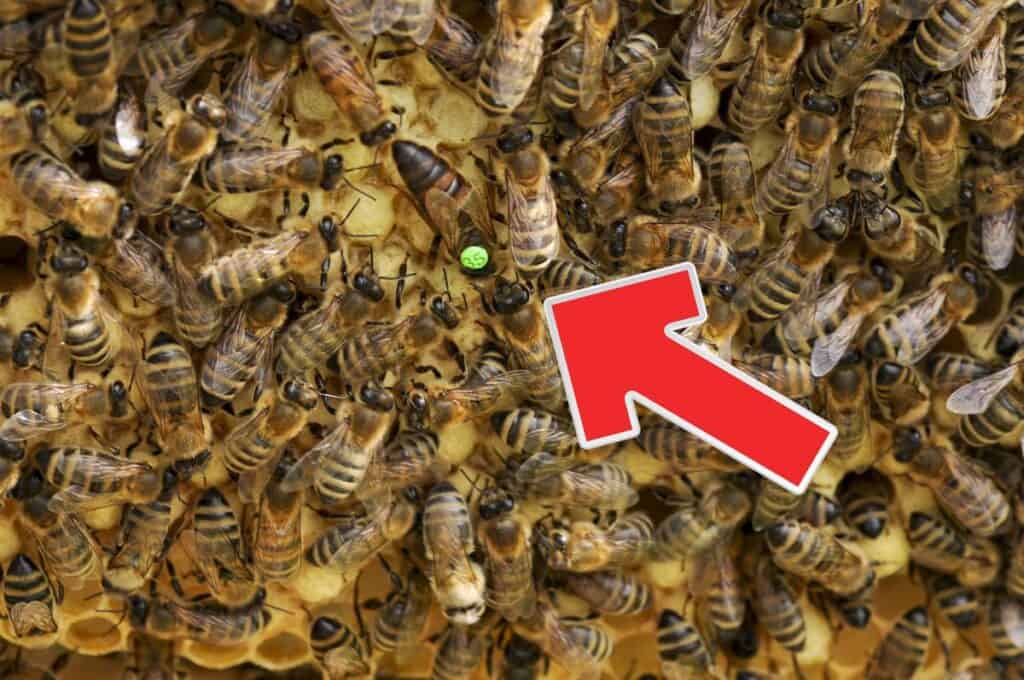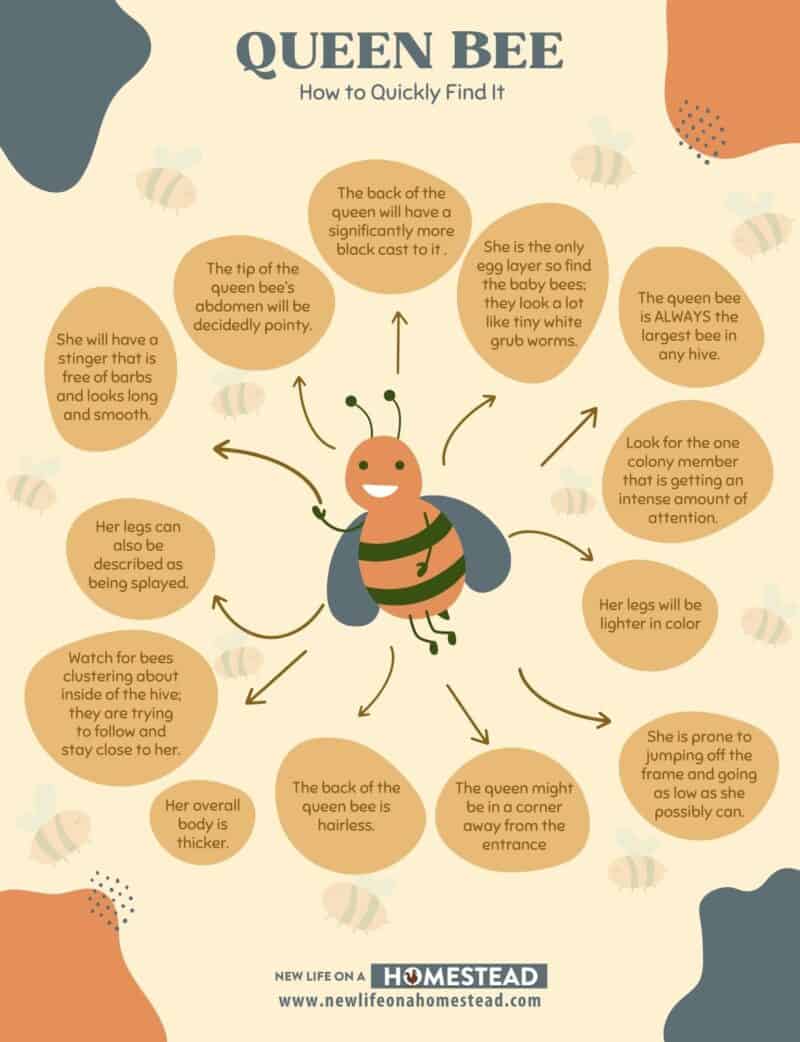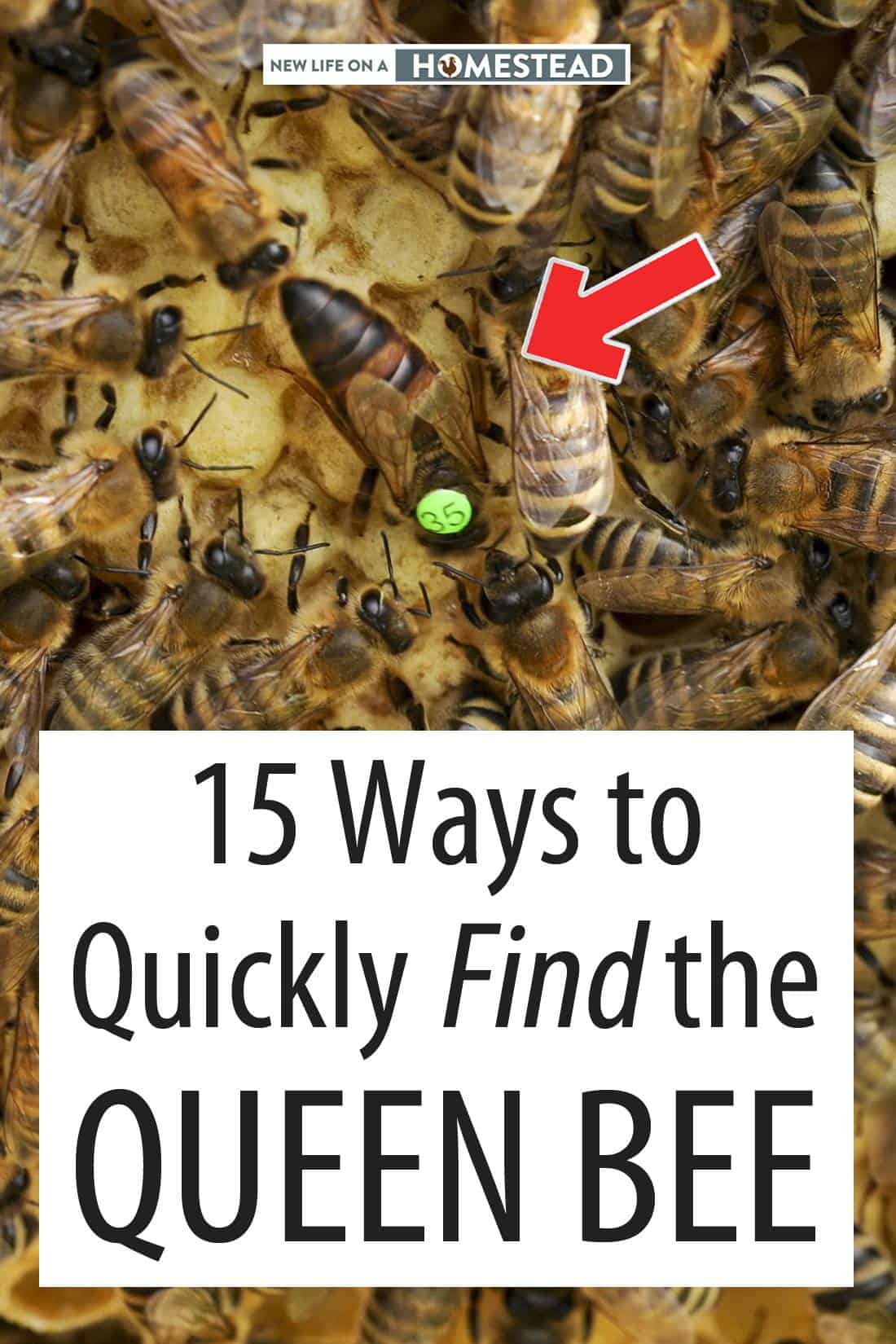Searching for the queen inside of a hive is often a daunting challenge – even for seasoned beekeepers. The bulky and shiny nature of a queen bee’s physique makes her discovery an easy one – but only if you get really lucky.
Most of the time, the queen is fairly naturally camouflaged amongst her subjects.

Each queen bee has her own distinct personality. Some queens prefer to mingle among the other bees and remain in a position of authority – much like a medieval monarch sitting on a throne.
Yet, other queens like to remain in a secluded place of safety, nestled among just a few other bees in the corner of the hive.
What Exactly Is A Queen Bee?
A queen bee is the leader inside a bee colony – the big boss if you will. She is the egg-laying bee and the mother of the vast majority – if not all, of the bees inside the hive.
The role of the queen honey bee is to grow or maintain the size of the honeybee colony. This is an important job as it increases the workforce; the fertilized eggs become workers (which are also female) and the unfertilized eggs become drones (male bees).
While the female bees are infertile, drones are meant to mate with the queen to ensure the survival of the colony. A honeybee hive must have a present and healthy queen in order to survive.
Once the queen bee gets old or dies, the hive will too if a new queen bee does not emerge or is not introduced in a very timely manner.
It is essential for a beekeeper to learn how to identify a queen bee to regularly check on the health of a hive. Marking the queen after you find her the first time is a simple task and one that will save time during later hive inspections.
Queen Bee Identification Methods
While queenspotting may seem like a game of Where’s Waldo for new beekeepers, there are three different methods that you can use alone (or more often) in conjunction with each other to identify a queen bee.
- Physical
- Behavioral
- Location

15 Ways To Identify A Queen Bee
- The queen bee is ALWAYS the largest bee in any hive. Scan the bees milling about on the frames when you open the lid and patiently and carefully watch to pinpoint the largest bee, she will be your queen. The queen bee’s body will be both narrower and longer than the bodies of all the other bees.
- The honeybee queen will have a long abdomen that extends out beyond the base tip of her wings – none of the other bees will have such a long abdomen. The tip of the queen bee’s abdomen will be decidedly pointy instead of more rounded like the rest of the bees in the colony.
- The back of the queen bee is hairless, it will not have little fuzzy hairs on it like the other colony members. The lack of hair often gives the back of the queen bee a more shiny appearance.
- The back of the queen bee will have a significantly more black cast to it instead of the yellow to gold with black stripes like the other bees co-existing inside of your hive.
- The legs of a queen bee will be lighter in color than the worker bees that surround her. The legs of the queen are also longer than those found on the workers or drones.
- Although it can be difficult to judge thickness amid the moving mass of bees, a queen bee is not just narrower and longer than the other bees, her overall body is thicker, as well.
- The queen bee’s legs can also be described as being splayed. Her legs are far more visible than the legs of the other honeybees in the hive because they are splayed outward and away from the body. The worker and drone bees have legs that are placed directly beneath their bodies, making them harder to spot when they are either walking or resting.
- Carefully inspect the stinger on any bee you suspect might be the hive queen. Lift the bee up by the middle of its body (the thorax), and gently hold it beneath a magnifying glass for closer inspection. You will be able to slightly but usually clearly, be able to determine the shape of its stinger using this inspection method. The active queen bee will have a stinger that is free of barbs and looks long and smooth. The stingers on worker, drone, and virgin queens will boast stingers with barbs – making it closely resemble a knife with a serrated edge on the lower half.
- Review the honeybee larvae present inside of the frames. Baby bees look a lot like tiny white grubworms. Typically, you will see the honeybee larvae piled up right next to each other. Because the queen bee is the only egg layer in a healthy hive, she should be hanging around next to her offspring. Always lift out the frames with great care to avoid accidentally smashing the queen in the process of searching for her inside of the hive.
- Search all of the other usual locations a queen bee could most likely be found, if she is not spotted by the honeybee larvae. None of the bees that are visible on the outside of the hive or even on the interior edges near the hive entrance will be the queen bee. As already noted, a shy or cautious queen might be in the corners of the hive – but always a corner away from the entrance. She is also often spotted in the deep frames of the hive – well protected from the outside world and attackers like robber bees, mice, ants, etc. If your beehive is a horizontal type, start searching for the queen in the center hives. If the honeybee has a vertical design, the queen bee will most likely be in or near the bottom of the frames.
- Queen bees are as smart as they are powerful. Once a human hand lifts the hive box lid and starts pulling out frames for inspection, she is prone to jumping off the frame and going as low as she possibly can to get away from what she likely deems as a threat.
- Watch for bees clustering about inside of the hive, this often means the queen is on the move and they are trying to follow and stay close to her. If you spot any honeybee larvae in an unusual spot, the queen could also quite possibly be in the near vicinity, as well.
- You may also see a parting of the bees when the queen bee is moving around inside of the hive. All the drone bees and worker bees will quickly clear a path for the colony royalty. The clustering noted above occurs behind her when she is moving and around her when she is still.
- Another way to quickly spot a queen bee is to scan the frames and search for the one bee that is not busying itself with chores. This would be the queen. If one bee is consistently still, merely awaiting food to be delivered and a time to mate, odds are great that she is the leader of the hive.
- Although it will take a trained eye and possibly a magnifying glass, you can also detect the queen bee inside the hive by looking for the one colony member that is getting an intense amount of attention and having food brought to her by other bees. This type of activity can occur with virgin queens or young queens as well as the active queen, but not to the same degree of attentiveness.
I Found The Queen Bee, Now What?
Once you discover the queen bee you can choose either to do nothing and simply search for her again during the next hive wellness check – or mark her.
Beekeepers often mark the queen bee with non-toxic acrylic paint so she can immediately be spotted and, in some cases, sold. Beekeepers who are not just keeping a hive for the honey, comb, or for pollination of crops, engage in breeding of queens for profit.
Most often, beekeepers who mark queens with paint use a color-coded system so they can identify the origin year of the hive royal. This process helps a beekeeper know when a queen is getting old and a new one will need to be introduced into the hive.
Queen Bee Color Marking Guide
- Use white paint for queens born in a year that ends with a number one or six.
- Use yellow paint for queens that earned their marking in years that end in two or seven.
- Red paint is used to mark a queen bee that is crowned during a year that ends in a three or an eight.
- Beekeepers dab a drop of green paint on a queen that is born in a year that ends in a four or a nine.
- Blue paint is used to mark queens born in a year that ends in a five or a zero
How To Mark A Queen Bee
- Carefully pick up the queen and hold her OVER the open hive. This will help prevent her from becoming overly agitated… usually. The queen must be picked up by her thorax and wings. Do not grab at any body part you can reach and latch on or run a big risk of tearing the queen’s wings or crushing her.
- The longer you hold a queen, no matter how carefully or where she is being kept captive, she will get mad and could injure herself attempting to get away – so have you paint pen or brush ready to go BEFORE picking up the queen bee. Another benefit of holding the queen bee directly over an open hive occurs if you accidentally drop the queen after picking her up. If she remains uninjured she will be back inside of her place of safety, and not somewhere in the grass where you would have to find her and try to pick her up again – without crushing her when moving your feet about during the search.
- Dab a little dot of pain onto the thorax of the queen bee, in the middle of the back in between where you see her front legs dangling about on either side. Be exact in the location of the paint dab and do not use too much paint or the liquid can attach to the wings or legs and gum them up to the point where the queen cannot move or fly – which WILL result in panicked movements.
Newbie beekeepers may have to spend more time searching for and finding a queen than more veteran honeybee keepers, even when following these useful tips.
Do not become discouraged, this is definitely an example of a practice makes perfect scenario. What is most important is finding the queen, not the number of minutes or number of tries it takes to do so.


Tara lives on a 56 acres farm in the Appalachian Mountains, where she faces homesteading and farming challenges every single day, raising chickens, goats, horses, and tons of vegetables. She’s an expert in all sorts of homesteading skills such as hide tanning, doll making, tree tapping, and many more.
